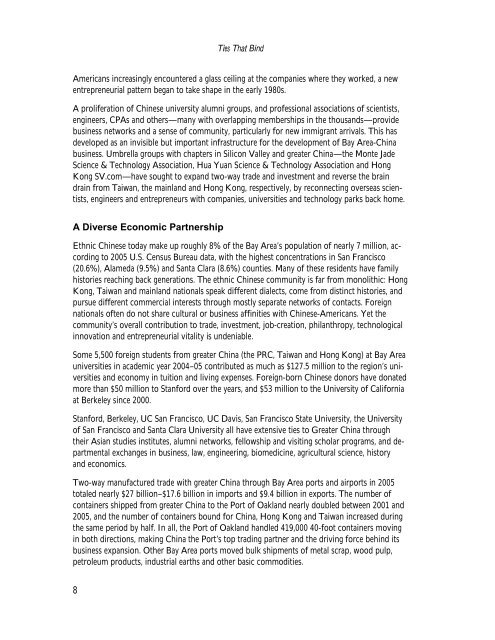Ties That Bind - Bay Area Council Economic Institute
Ties That Bind - Bay Area Council Economic Institute
Ties That Bind - Bay Area Council Economic Institute
Create successful ePaper yourself
Turn your PDF publications into a flip-book with our unique Google optimized e-Paper software.
8<br />
<strong>Ties</strong> <strong>That</strong> <strong>Bind</strong><br />
Americans increasingly encountered a glass ceiling at the companies where they worked, a new<br />
entrepreneurial pattern began to take shape in the early 1980s.<br />
A proliferation of Chinese university alumni groups, and professional associations of scientists,<br />
engineers, CPAs and others—many with overlapping memberships in the thousands—provide<br />
business networks and a sense of community, particularly for new immigrant arrivals. This has<br />
developed as an invisible but important infrastructure for the development of <strong>Bay</strong> <strong>Area</strong>-China<br />
business. Umbrella groups with chapters in Silicon Valley and greater China—the Monte Jade<br />
Science & Technology Association, Hua Yuan Science & Technology Association and Hong<br />
Kong SV.com—have sought to expand two-way trade and investment and reverse the brain<br />
drain from Taiwan, the mainland and Hong Kong, respectively, by reconnecting overseas scientists,<br />
engineers and entrepreneurs with companies, universities and technology parks back home.<br />
A Diverse <strong>Economic</strong> Partnership<br />
Ethnic Chinese today make up roughly 8% of the <strong>Bay</strong> <strong>Area</strong>’s population of nearly 7 million, according<br />
to 2005 U.S. Census Bureau data, with the highest concentrations in San Francisco<br />
(20.6%), Alameda (9.5%) and Santa Clara (8.6%) counties. Many of these residents have family<br />
histories reaching back generations. The ethnic Chinese community is far from monolithic: Hong<br />
Kong, Taiwan and mainland nationals speak different dialects, come from distinct histories, and<br />
pursue different commercial interests through mostly separate networks of contacts. Foreign<br />
nationals often do not share cultural or business affinities with Chinese-Americans. Yet the<br />
community’s overall contribution to trade, investment, job-creation, philanthropy, technological<br />
innovation and entrepreneurial vitality is undeniable.<br />
Some 5,500 foreign students from greater China (the PRC, Taiwan and Hong Kong) at <strong>Bay</strong> <strong>Area</strong><br />
universities in academic year 2004–05 contributed as much as $127.5 million to the region’s universities<br />
and economy in tuition and living expenses. Foreign-born Chinese donors have donated<br />
more than $50 million to Stanford over the years, and $53 million to the University of California<br />
at Berkeley since 2000.<br />
Stanford, Berkeley, UC San Francisco, UC Davis, San Francisco State University, the University<br />
of San Francisco and Santa Clara University all have extensive ties to Greater China through<br />
their Asian studies institutes, alumni networks, fellowship and visiting scholar programs, and departmental<br />
exchanges in business, law, engineering, biomedicine, agricultural science, history<br />
and economics.<br />
Two-way manufactured trade with greater China through <strong>Bay</strong> <strong>Area</strong> ports and airports in 2005<br />
totaled nearly $27 billion–$17.6 billion in imports and $9.4 billion in exports. The number of<br />
containers shipped from greater China to the Port of Oakland nearly doubled between 2001 and<br />
2005, and the number of containers bound for China, Hong Kong and Taiwan increased during<br />
the same period by half. In all, the Port of Oakland handled 419,000 40-foot containers moving<br />
in both directions, making China the Port’s top trading partner and the driving force behind its<br />
business expansion. Other <strong>Bay</strong> <strong>Area</strong> ports moved bulk shipments of metal scrap, wood pulp,<br />
petroleum products, industrial earths and other basic commodities.








